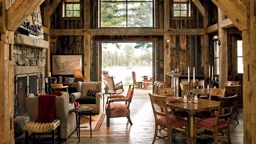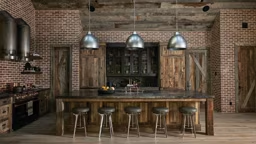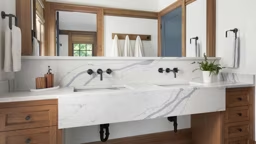
Photo: Golden Eagle Log & Timber Homes
While starting with logs or timbers puts you ahead of the game — wood environments have been proven to curb stress hormones and blood pressure — there are other strategic design decisions you can make to cultivate calm and boost happiness in your home. Read on for our top 10 tips, straight from the pros’ lips.
James Kroeker - Lead Designer at Trinity Building Systems
Matt Franklin - Lead Designer at M.T.N Design
Allen Halcomb - President of MossCreek

Photo: Adobe Stock / ©Photographee.eu
1. Pursue Your Pastimes
Doing more of what you love naturally leads to better moods, so carve out space in your home where you can be intentional about pursing activities you find personally fulfilling. If it’s crafting, convert that under-utilized spare bedroom into a hobby room. If you’re an avid collector, create an area to display your prized items. “Dedicating a space to something you enjoy, whether it’s a hobby or a field of study, gives you an escape from everyday life,” says Allen.2. Go With the Flow
If you’ve ever been in a crowded room, you know it can trigger feelings of uneasiness. The effect is even more trying if you’re attempting a specific task, such as cooking in a tiny kitchen while someone else loads the dishwasher.

Photo: Heidi Long photo; PrecisionCraft Log & Timber Homes
3. Color Me Happy
How you use color in your home — whether it’s painted drywall or the shade of your couch — can go a long way toward establishing a sense of peace. “We could all use a little stress-relief in our lives right now, and color is a good place to start,” says Matt. “Reds and yellows are more tense, while greens, blues and warm gray are soothing.”4. Sleep Savvy
It’s no secret that getting quality Z’s is a key to keeping stress in check. To ensure your master bedroom is a sanctuary that allows you to rest and recharge, follow these key steps: “Make the master suite as private as possible by placing it away from the louder, public spaces,” says Matt. “Psychologically, the distance gives you a transition between those two worlds, so you get into a mindset that is more peaceful and relaxed.” Next, make it spa-like by including a sitting area, nixing the TV and incorporating soft colors and fabrics.

Photo: Timberbuilt, by Kim Smith of Buffalo Photos
5. Make an Entrance
It’s no secret that first impressions matter and that mess causes stress. So what’s the takeaway when it comes to home design? Be particularly thoughtful about entrances.
The last thing you want is to be greeted by clutter the moment you step through the door. If you access your home primarily through a garage entry, include a mudroom to act as a buffer space. It’s typical to include plenty of cubbies or hooks for shoes, jackets and bags, but Matt also suggests adding a counter for things like bills, house keys and even a charging station. “The space will serve as a decompression chamber as you go for the car and the outside world to the home itself,” he says.

Photo: californiaclosets.com
6. Clear the Clutter
All three of our experts agreed that having ample storage was a “must” for designing a stress-free home. Allen put it this way: “When there is clutter everywhere, it makes things appear to be out of control. Whatever volume of storage you think you need, double it.” Get creative by looking to carve out storage in unused areas, such as under a stairwell, in an attic, under low-hanging eaves or by adding bump-outs to the garage. And Matt reminds us not to forget to have both a coat closet and a broom closet on the main floor. Afterall, you won’t want to hang guests’ coats alongside your mops and vacuums.7. Don’t Pass on Glass
To keep your interiors (and you) feeling mellow, natural lighting is key. “It’s good for your soul,” says James. “It just kind of perks you up.” While he’s a big fan of the traditional window walls used in the great rooms of log and timber homes, he recommends giving thought to commonly overlooked areas when it comes to glass. “I try to put a window in a bathroom and even a walk-in closet, something like a transom can be a good fit for those areas.”

Photo: Heidi Long
8. Embrace Outdoor Living
Spending quality time outside is proven to make us healthier and happier humans, and the mood-boosting effects are even more impressive when you share the experience with those you love. “There’s a graciousness about enjoying company in pleasant weather,” says Allen. He loves to incorporate large doors that open up to create indoor-outdoor living spaces, while Matt recommends a mix of covered and uncovered spaces outdoors: “So you can soak in the sun when you want to, but still relax and enjoy the space during a cool summer thunderstorm.”9. Get Smarter
Managing a home is no small job. Smart home products and appliances can cut down the hassle and stress of everyday tasks. Smart lighting systems can turn off all lights at the touch of a button (not to mention create inviting “mood” lighting), smart speakers can play music that produces feel-good dopamine and smart cleaning tools, like a robotic vacuum, can shorten household chores, giving us more time to relax and unwind. “It’s a little luxury that can have a dramatic impact,” says Allen.10. Work Less
While a little work is good for the soul, constant upkeep just leads to frustration. The key to spending more time relaxing and less time maintaining your home lies in your product and material choices. Opt for forgiving finishes inside and durable choices on your exterior, such as stone veneer accents, low-maintenance decking and aluminum soffits and facia. “The goal is to make your home easy to live in,” says James.
See also: A Dream Home Built for Rustic Relaxation











